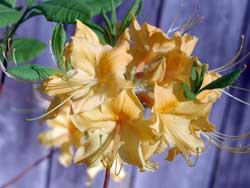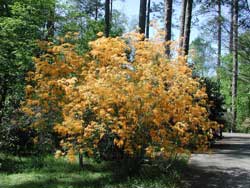Resource Library
Plant of the Week: Florida Azalea
The University of Arkansas System Division of Agriculture does not promote, support or recommend plants featured in "Plant of the Week." Please consult your local Extension office for plants suitable for your region.
Plant of the Week
Florida Azalea
Latin: Rhododendron austrinum

Though I've never made the spring break trek to sunny Florida, I get a whiff of salty sea air each spring when my Florida azalea blooms in mid-April. Though I have a collection of way too many azaleas that cry out for attention in the spring garden, few give me as much satisfaction as this spring-blooming beauty.
Florida azalea (Rhododendron austrinum) is a multi-stemmed deciduous shrub growing 6 to 8 feet tall and wide. Plant habit is somewhat open and irregular, but with branching coming from a single, tight crown. Its leaves are 3 to 4 inches long, oblong-oval in outline and will occasionally have yellow tints in the fall as they shed from the plant with the first frost. The foliage appears about the time the flowers reach full bloom.
The flowers of Florida azalea are produced in a terminal truss that may contain from eight to 15 blooms and be up to 5 inches across. The color range centers on yellow and yellow-orange, but can vary from light yellow to red-orange. Blossoms have a narrow, inch-long tube that is often flushed with red and covered with sticky, glandular hairs. Five petals flatten out at the end of the tube to 1 to 2 inches across. Each flower has five long, exerted stamens extending out of the blossom. Like most native azaleas, the blooms have a very sweet, honeysuckle-like fragrance.
North America has 17 species of native azaleas, all but one being located in the Southeastern states. Most species are found in cool mountain regions, but not the Florida azalea. It has a very small natural distribution range extending from the Florida panhandle and contiguous parts of Georgia westward to Mississippi. Nowhere in its natural range does it get more than about 100 miles from the Gulf of Mexico.
The plant was first described by Dr. A. W. Chapman before 1865. The species' epitaph, as assigned by Harvard's botanical expert Alfred Rehder, means “southern.” It has been grown in cultivation since at least 1914.

Though this narrow natural distribution pattern might predict a plant difficult to grow out of its normal range, Rhododendron austrinum is perhaps the easiest to grow of our native deciduous azaleas. What it has that other of its kin lack is heat tolerance and general root adaptability. And, as any southern gardener knows, heat can be a problem down South.
The Florida azalea is hardy into zone 6 through zone 9. It does best in light shade, but will take full sun as long as attention is paid to watering during the summer months. It is best suited to a sand-based, acidic soil, but will tolerate heavier soils (but not clay) so long as drainage is good. Once established, the plant has considerable drought tolerance. Use it near the patio or on a pathway to the front door so the fragrance can be enjoyed, or as a part of a mixed border planting. If pruning is needed to control size, do so after the plant finishes blooming.
About a dozen cultivars are listed of Florida azalea, but, like most native azaleas, propagation is challenging and nursery production slow, so finding named selections can be difficult. Most plants offered are seed grown, which gives a nice array of color possibilities for the garden.
By: Gerald Klingaman, retired
Extension Horticulturist - Ornamentals
Extension News - April 30, 2010
The University of Arkansas System Division of Agriculture does not maintain lists of retail outlets where these plants can be purchased. Please check your local nursery or other retail outlets to ask about the availability of these plants for your growing area.